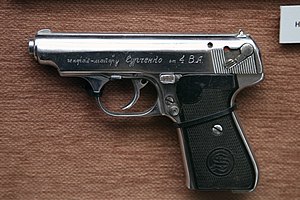
A semi-automatic pistol is a type of repeating single-chamber handgun (pistol) that automatically cycles its action to insert the subsequent cartridge into the chamber (self-loading), but requires manual actuation of the trigger to actually discharge the following shot. As a result, only one round of ammunition is fired each time the trigger is pulled, as the pistol's fire control group disconnects the trigger mechanism from the firing pin/striker until the trigger has been released and reset.

Several brother companies that design and manufacture firearms use the brand name SIG Sauer[ɛs iː ɡeː ˈzaʊ̯ɐ]. The original company, Schweizerische Waggon-Fabrik (SWF), later Schweizerische Industrie-Gesellschaft (SIG), went through several selloffs, leaving the SIG Sauer brand spread over several companies. The original SIG is now known as SIG Combibloc Group and no longer has any firearms business.
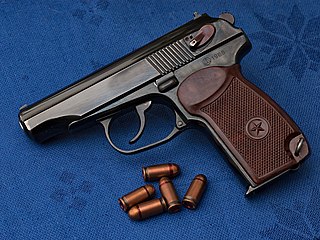
The Makarov pistol or PM is a Soviet semi-automatic pistol. Under the project leadership of Nikolay Fyodorovich Makarov, it became the Soviet Union's standard military and Militsiya side arm in 1951.
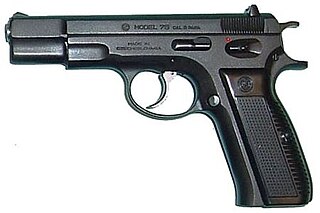
The CZ 75 is a semi-automatic pistol made by Czech firearm manufacturer ČZUB. First introduced in 1975, it is one of the original "wonder nines" and features a staggered-column magazine, all-steel construction, and a hammer forged barrel. It is widely distributed throughout the world and is the most common handgun in the Czech Republic.

The Smith & Wesson Model 1006 is a recoil operated double-action/single-action semi-automatic handgun chambered in the 10mm Auto cartridge manufactured by Smith & Wesson.

The SIG Sauer P220 is a semi-automatic pistol. Designed in 1975 by the SIG Arms AG division of Schweizerische Industrie Gesellschaft, and produced by J. P. Sauer & Sohn, in Eckernförde; it is currently manufactured by both SIG Sauer companies: SIG Sauer GMBH, of Eckernförde, Germany; and SIG Sauer, Inc., of New Hampshire, United States.

The SIG Sauer P226 is a full-sized, service-type pistol made by SIG Sauer. This model is sold with a choice of four chambers to choose from: the 9×19mm Parabellum, .40 S&W, .357 SIG, or .22 Long Rifle. It has essentially the same basic design as the SIG Sauer P220, but is developed to use higher capacity, double stack magazines in place of the single stack magazines of the P220.
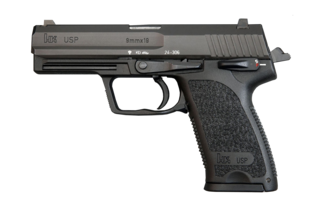
The USP is a semi-automatic pistol developed in Germany by Heckler & Koch GmbH (H&K) as a replacement for the P7 series of handguns.

The Heckler & Koch P2000 is a German semi-automatic pistol introduced late in 2001 and intended primarily for law enforcement, paramilitary, and commercial markets. It is based on the USP Compact pistol. The P2000 was designed specifically with improved ergonomic characteristics; it has features that reduce handling related stresses, while at the same time increasing user handling and comfort.

In American English, a pocket pistol is any small, pocket-sized semi-automatic pistol, and is suitable for concealed carry in either a coat, jacket, or trouser pocket.

A trigger is a mechanism that actuates the function of a ranged weapon such as a firearm, airgun, crossbow, or speargun. The word may also be used to describe a switch that initiates the operation of other non-shooting devices such as a trap, a power tool or a quick release. A small amount of energy applied to the trigger leads to the release of much more energy.

J. P. Sauer und Sohn GmbH is a manufacturer of firearms and machinery and is the oldest firearms manufacturer still active in Germany. The products of this company are frequently referred to as Sauer.

The Beretta 90-Two is a series of semi-automatic pistols designed and manufactured by Beretta of Italy. It was released in 2006 as an enhanced version of the Beretta 92, and is produced in 9×19mm, 9×21mm IMI and .40 S&W versions.
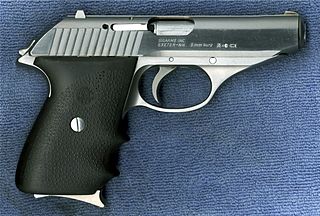
The SIG Sauer P230 is a small, semi-automatic handgun chambered in .32 ACP or .380 Auto. It was designed by SIG Sauer of Eckernförde, Germany. It was imported into the United States by SIGARMS in 1985. In 1996 it was replaced by the model P232.

FN HP-DA is a 9mm semi-automatic pistol developed by Belgian Fabrique Nationale arms factory in Herstal. In North American markets, it was marketed as Browning BDA and is also referred to as Browning DA and Browning Hi-Power BDA.
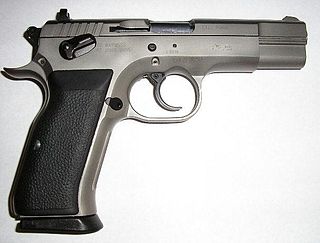
The Tanfoglio Combat or Standard, also known as T(A)95 or EAA Witness Steel, is a modified clone of the Czech CZ-75/CZ-85 pistol. It is made in Gardone Val Trompia near Brescia, Italy by Fratelli Tanfoglio S.N.C.
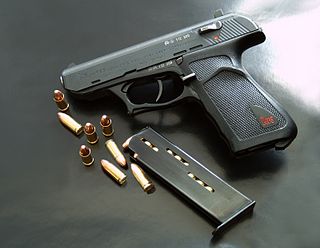
The HK P9 is a semi-automatic pistol from Heckler & Koch in 9×19mm Parabellum, .45 ACP, and 7.65×21mm Parabellum and the first to use a variation of H&K's roller delayed blowback system in a pistol format and polygonal rifling now common in H&K designs.

In firearms, a safety or safety catch is a mechanism used to help prevent the accidental discharge of a firearm, helping to ensure safer handling.

The SIG Sauer P227 is an American-designed and produced semi-automatic pistol which was introduced in 2013 and discontinued in 2019. The P227 introduced a double-stack .45 ACP caliber handgun into the SIG Sauer lineup. It was introduced along with the P224.

The SIG Sauer P365 is a striker-fired subcompact semi-automatic pistol manufactured by SIG Sauer, intended for everyday carry. It is offered with Tritium XRAY3 Day/Night Sights and two 10-round magazines; one flush fit and the other with an extended finger tab, and a stainless steel frame with polymer grip module. It is primarily chambered in 9×19mm Parabellum and is rated for +P ammunition while utilizing offset double-stack magazines. A variant chambered in .380 ACP was introduced in February 2022. The P365, which replaced the P290RS, is produced in Newington, New Hampshire. In both 2018 and 2019, it was the best selling handgun in the United States.
